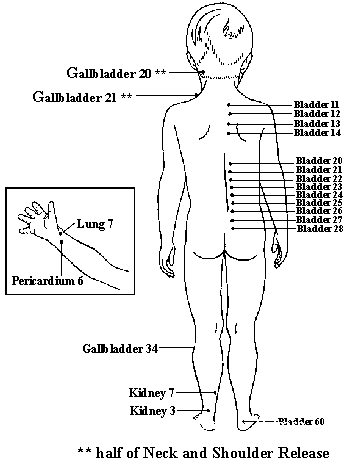The gentle art of acupressure is something you can do at home for a sick or hurting child. Massaging an acupressure point will help relieve symptoms as well as strengthen your child's body.
Acupressure points are located along lines called meridians that run along the sides of the body. There are twelve of these meridians on each side of the body, each corresponding to and named for a specific organ. Pressure points are identified by numbers that indicate where they fall along a particular meridian. Spleen 6, for example, is the sixth point along the Spleen meridian.
In the sections on individual health conditions in Smart Medicine for a Healthier Child,
specific pressure points are recommended for treatment of different disorders.
Use the following diagrams to help you locate specific pressure points on the body. The front view shows points for the Four Gates combination and the Large Intestine, Liver, Spleen, and Stomach meridians. The back view shows points for Neck and Shoulder Release and the Bladder, Gallbladder, and Kidney meridians. The inset of the hand and arm shows points on the Lung and Pericardium meridians.
To give an acupressure treatment, choose a time when your child is relatively calm and relaxed. Make sure he is warm enough. You can apply pressure either directly to his body, or through a shirt or light sheet. Have your child breathe deeply for a few moments to aid relaxation. You may wish to start by giving a back rub, and then move into the acupressure treatment itself.
Expect the acupressure points relevant to your child's condition to be somewhat tender to the touch. Use your judgment. Ask your child what feels good.
When administering acupressure, work the right- and left-side points at the same time whenever possible (if it's not, work one side first and then the other). Using your fingers or thumbs, apply threshold pressure to the points. This is firm pressure that is just on the verge of being painful; the point is stimulated but the body doesn't tighten up or retract from the pain. It is a "good hurt" feeling.
Apply from one to three minutes of continuous threshold pressure until the pain is relieved. Or apply pressure for ten seconds, release for ten seconds, apply pressure again for ten seconds, and release again; repeat this sequence ten times.
There are two special acupressure techniques suggested for several of the health
problems discussed in the sections on individual health conditions:
Four Gates Technique. Four Gates is a traditional Chinese point combination that has been used by acupuncturists for centuries. Working these points with acupressure will enhance relaxation and help relieve pain, nervousness, anxiety, and sleeplessness. Traditional Chinese doctors believe that working these points "opens the gates" of energy flow in the body. For this technique only, work first on one side of the body and then on the other. Apply pressure simultaneously to Liver 3 and Large Intestine 4.
Neck and Shoulder Release. This is another traditional point combination, used to release the trapezius and other neck and shoulder muscles. Apply threshold pressure to Gallbladder 20 on the right and left sides, until you feel the muscle relax. Then do the same with Gallbladder 21.
Administering an Acupressure Treatment


Figure 3.1 of Common Acupressure Points on a Child's Body
The illustration above and at right show the locations of the accupressure points recommended in the various entries on common childhood health problems. Points on the Governing Vessel, Large Intestine, Liver, Spleen, and Stomach meridians, and the points for the Four Gates technique, are indicated on the front view of the child's body. Points on the Bladder, Gallbladder, and Kidney meridians, and the points for Neck and Shoulder Release, are shown on the back view.
From Smart Medicine for a Healthier Child by Janet Zand, N.D., L.Ac., Robert Rountree, MD, Rachel Walton, RN, ©1994. Published by Avery Publishing, New York. For personal use only; neither the digital nor printed copy may be copied or sold. Reproduced by permission.